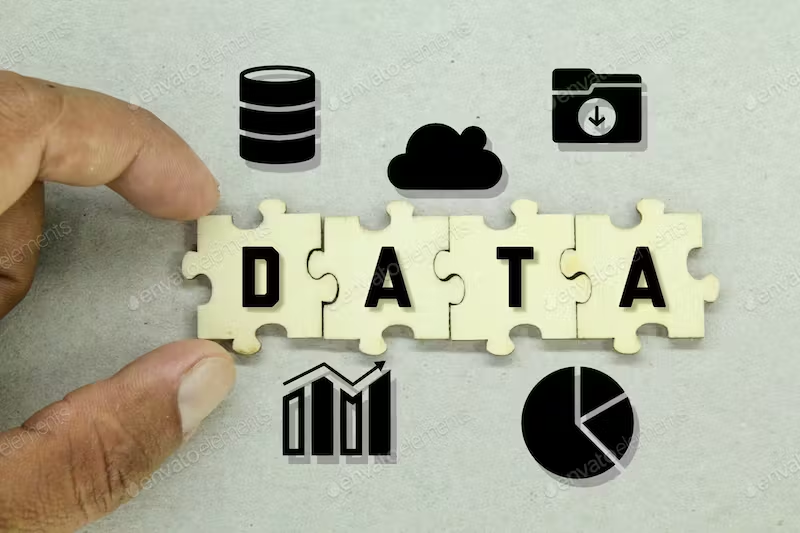In the age of digital technology, data has gained a worth comparable to gold. The transition it experiences, evolving from its raw, unprocessed state into actionable intelligence, is no less than a magical journey. Every click, swipe, or tap generates a wealth of data, and our proficiency in converting this digital raw material into valuable insights drives modern decision-making procedures. Come with us as we delve into “The Evolution of Data,” embarking on a journey through both time and technology.
- The Data Revolution
Envision this: a world with no smartphones, social media, or online shopping. It’s the year 1980, and data, in its current form, is just starting to take shape. During this period, data was mostly restricted to handwritten records, physical ledgers, and the occasional floppy disk. Fast forward to today, and data has undergone a monumental shift. We currently inhabit an age where data is produced at an astonishing pace, with each individual generating roughly 1.7 megabytes of data every second.
Data is more than just numbers in a spreadsheet. It’s a chameleon, taking on various forms to suit our needs. There’s structured data, which fits neatly into rows and columns, and unstructured data, a wild, untamed jungle of information found in emails, social media posts, and multimedia files. Imagine the complexity of processing and understanding these vast data ecosystems!
Think about your last online shopping spree. The items you browsed, the reviews you read, and even the products you placed in your cart but didn’t buy—all of it is data. It’s this web of information that businesses can harness to understand your preferences and offer you personalized shopping experiences.
- From Raw Data to Information
The journey from raw data to information is like turning raw ingredients into a gourmet dish. Raw data is like uncooked pasta—a jumble of numbers, letters, and symbols. It’s only after cooking and seasoning (processing and analysis) that it becomes a delightful meal (information).
Consider a stock market trader. They’re bombarded with data from various sources—stock prices, news articles, and economic indicators. The trader’s success depends on their ability to turn this raw data into actionable information. Through complex algorithms and real-time analysis, they identify trends and make split-second decisions.
- The Role of Technology: Data Analytics, Insights, and Data Visualization
Technology is the wizard behind the data transformation curtain. It’s the magician’s wand that turns raw data into actionable intelligence. Databases, data warehouses, and big data technologies are the backstage crew that ensure the show runs smoothly.
Think about Netflix’s recommendation engine. It analyzes your viewing history, compares it to millions of other users, and magically suggests the next binge-worthy series. It’s all powered by technology’s ability to process colossal amounts of data and make it useful.
Data analytics is the foundation that facilitates the transformation of raw information into useful data. It involves using statistical techniques, machine learning algorithms, etc. to unearth insights. Take the healthcare industry, for example. Doctors use data analytics to predict disease outbreaks, optimize treatment plans, and even predict patient outcomes.
Data visualization is another important technology that helps transform dry data into captivating works of art that tell stories. Beyond traditional pie charts and bar graphs, modern data visualization tools have evolved to craft interactive, three-dimensional depictions of intricate data collections. These tools simplify the process of grasping insights for decision-makers.
Consider a scenario where a city planner utilizes data visualization to dynamically chart traffic patterns and congestion. This capability empowers them to make well-informed choices regarding traffic management in real-time.
- Challenges and Ethical Considerations
When using raw information to collect actionable intelligence, there are several challenges and ethical considerations that must be taken into account. These include:
- Data Privacy: Safeguarding individuals’ privacy remains a top priority. The gathering and retention of personal data must align with relevant data protection regulations, such as GDPR in Europe or HIPAA in the United States. For this, the use of advanced and reliable synthetic data generation tools is highly recommended.
- Data Security: The perpetual challenge lies in fortifying data against unauthorized access, breaches, or cyberattacks. It is imperative to institute robust security measures to safeguard sensitive information.
- Data Accuracy: Raw data may harbor errors, duplications, or inconsistencies. Guaranteeing data accuracy through procedures like data cleansing and validation is essential to prevent decisions based on flawed information.
- Data Bias: Bias can permeate both raw data and the algorithms employed in analysis. Confronting bias and upholding fairness in data collection and analysis stands as an ethical concern, particularly in domains like AI and machine learning.
- Data Ownership: Unraveling the complexities of data ownership, particularly in scenarios involving third-party data collection or sharing, can be intricate. Ethical deliberations regarding data ownership and usage rights must be resolved.
- Data Transparency: Transparent disclosure of data collection practices and the purpose behind data utilization is indispensable. Users should be informed about the particulars of information collection and its intended uses.
Conclusion
As we look to the future, artificial intelligence, quantum computing, and advanced data analytics promise to take data evolution to even greater heights. Imagine AI-powered virtual assistants that understand your needs better than you do or quantum computers that can process vast datasets in seconds.
The evolution of data is a tale of transformation, from raw, unrefined information to actionable intelligence that shapes our world. As we navigate this digital landscape, our ability to harness data’s power will define our success. Just remember, the next time you click, swipe, or tap, you’re contributing to the ever-continuing saga of data evolution. And who knows what incredible insights and innovations lie ahead in this thrilling journey?







